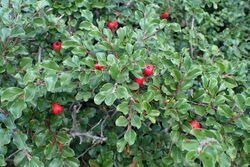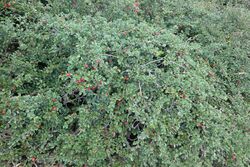Biology:Cotoneaster apiculatus
From HandWiki
Short description: Species of plant in the family Rosaceae
| Cotoneaster apiculatus | |
|---|---|

| |
| The showy, persistent fruit remain on the plants into the winter.[1] | |

| |
| Habit | |
| Scientific classification | |
| Kingdom: | Plantae |
| Clade: | Tracheophytes |
| Clade: | Angiosperms |
| Clade: | Eudicots |
| Clade: | Rosids |
| Order: | Rosales |
| Family: | Rosaceae |
| Genus: | Cotoneaster |
| Species: | C. apiculatus
|
| Binomial name | |
| Cotoneaster apiculatus Rehder & E.H.Wilson
| |
| Synonyms[2] | |
| |
Cotoneaster apiculatus, the cranberry cotoneaster, is a species of flowering plant in the family Rosaceae.[3][4] It is native to central China, and it has been introduced to various locales in Europe and the United States.[2] A rabbit-tolerant shrub reaching 3 ft (1 m) tall but spreading to 6 ft (2 m), and hardy in USDA zones 4 through 7, it is recommended for covering large areas.[5] It is good on streambanks and slopes where erosion control is desired, as its branches will grow roots where they touch soil.[5]
References
- ↑ Jauron, Richard (5 November 2004). "Trees and Shrubs with Colorful Fruit in Fall and Winter". Iowa State University. https://hortnews.extension.iastate.edu/2004/11-5-2004/colorful.html.
- ↑ 2.0 2.1 "Cotoneaster apiculatus Rehder & E.H.Wilson" (in en). Royal Botanic Gardens, Kew. http://www.plantsoftheworldonline.org/taxon/722413-1.
- ↑ GBIF Backbone Taxonomy. "Cotoneaster apiculatus Rehder & E.H.Wilson". GBIF Secretariat. https://www.gbif.org/species/3025857.
- ↑ "Cotoneaster apiculatus". The Royal Horticultural Society. 2022. https://www.rhs.org.uk/plants/4577/i-cotoneaster-apiculatus-i/details. "Synonyms; Cotoneaster duthieanus 'Boer', Cotoneaster praecox 'Boer', Cotoneaster nanshan 'Boer', Cotoneaster adpressus 'Boer' ... 2 suppliers"
- ↑ 5.0 5.1 "Cotoneaster apiculatus". Missouri Botanical Garden. https://www.missouribotanicalgarden.org/PlantFinder/PlantFinderDetails.aspx?taxonid=286500.
Wikidata ☰ Q15228489 entry
 |

